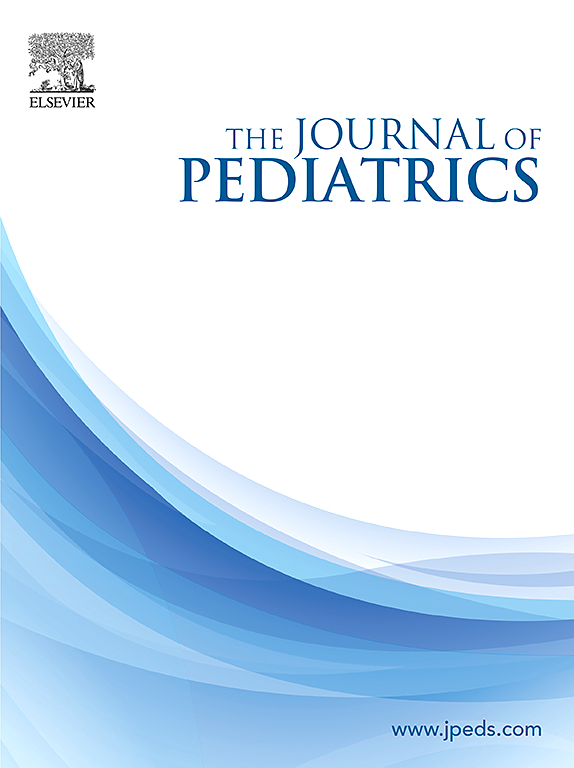在8-17岁儿童中,身体圆度指数比身体质量指数更能预测心脏代谢风险。
IF 3.5
2区 医学
Q1 PEDIATRICS
引用次数: 0
摘要
目的:确定身体圆度指数(BRI)是否比体重指数(BMI)更能预测儿童的心脏代谢结果。方法:本横断面研究纳入了2015-2020年NHANES数据库中3996名8-17岁儿童。暴露是BMI和BRI z分数。主要结局为高血压(BP)和BP指数;次要结局是血清葡萄糖、胰岛素和甘油三酯水平。对复杂回归模型进行了年龄、性别、贫困指数比率、粮食不安全和能源消耗的调整。结果:BRI和BMI z评分分别与收缩压和舒张压指数相关。BMI模型中加入BRI增强了与舒张期血压指数的关联,但与收缩期血压指数没有关联。虽然BMI z-评分与高血压血压无关,但BRI z-评分与高血压血压显著相关(OR 1.497, 95% CI[1.175-1.907])。结论:与BMI相比,BRI是一个更强的心脏代谢结局预测因子,为儿童心血管风险评估提供了增加价值。未来的研究应该验证这些发现,并探索BRI在儿科环境中的临床应用。本文章由计算机程序翻译,如有差异,请以英文原文为准。
Body Roundness Index is a Stronger Predictor of Cardiometabolic Risk than Body Mass Index in Children between Ages 8 to 17 years
Objective
To determine whether body roundness index (BRI) is a stronger predictor of cardiometabolic outcomes compared with body mass index (BMI) in children.
Methods
This cross-sectional study included 3996 children aged 8-17 from the 2015-2020 National Health and Nutrition Examination Survey database. Exposures were BMI and BRI z-scores. Primary outcomes were hypertensive blood pressure (BP) and BP index; secondary outcomes were serum glucose, insulin, and triglyceride levels. Complex regression models were adjusted for age, sex, poverty index ratio, food insecurity, and energy expenditure.
Results
BRI and BMI z-scores were individually associated with systolic and diastolic blood pressure indices. The addition of BRI to the BMI model strengthened the association with diastolic BP index, but not for systolic BP index. Although BMI z-scores were not associated with hypertensive BP, BRI z-scores were significantly associated with hypertensive BP (OR 1.497, 95% CI [1.175-1.907], P < .01). Adding BRI to BMI models improved the predictive fit for hypertensive BP as well as serum glucose, insulin, and triglyceride levels.
Conclusions
BRI is a stronger predictor of cardiometabolic outcomes compared with BMI, providing incremental value in cardiovascular risk assessment in children. Future studies should validate these findings and explore the clinical utility of BRI in pediatric settings.
求助全文
通过发布文献求助,成功后即可免费获取论文全文。
去求助
来源期刊

Journal of Pediatrics
医学-小儿科
CiteScore
6.00
自引率
2.00%
发文量
696
审稿时长
31 days
期刊介绍:
The Journal of Pediatrics is an international peer-reviewed journal that advances pediatric research and serves as a practical guide for pediatricians who manage health and diagnose and treat disorders in infants, children, and adolescents. The Journal publishes original work based on standards of excellence and expert review. The Journal seeks to publish high quality original articles that are immediately applicable to practice (basic science, translational research, evidence-based medicine), brief clinical and laboratory case reports, medical progress, expert commentary, grand rounds, insightful editorials, “classic” physical examinations, and novel insights into clinical and academic pediatric medicine related to every aspect of child health. Published monthly since 1932, The Journal of Pediatrics continues to promote the latest developments in pediatric medicine, child health, policy, and advocacy.
Topics covered in The Journal of Pediatrics include, but are not limited to:
General Pediatrics
Pediatric Subspecialties
Adolescent Medicine
Allergy and Immunology
Cardiology
Critical Care Medicine
Developmental-Behavioral Medicine
Endocrinology
Gastroenterology
Hematology-Oncology
Infectious Diseases
Neonatal-Perinatal Medicine
Nephrology
Neurology
Emergency Medicine
Pulmonology
Rheumatology
Genetics
Ethics
Health Service Research
Pediatric Hospitalist Medicine.
 求助内容:
求助内容: 应助结果提醒方式:
应助结果提醒方式:


